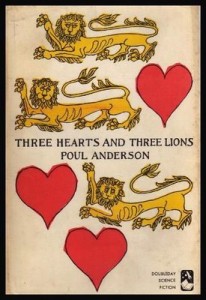Poul Anderson ISBN 0-441-80822-0
Three Hearts and Three Lions was published in 1953, well after Tolkien’s The Hobbit but approximately contemporary with The Lord of the Rings. Whether Poul Anderson had read The Hobbit isn’t easy to determine, but it’s safe to say this is a sphere of fantasy sub-creation that lies outside the influence of Tolkien, well outside of The Lord of the Rings, and it could well have founded its own whole genre. In a way, it has, though I’ll come back to that. There are Elves and Goblins, Dwarves and Trolls, but none of them are quite what you expect coming from the modern Tolkien-saturated fantasy landscape.
Unlike the more quasi-historical The Broken Sword (published in 1954 and revised in 1971), this is Anderson doing Wardrobe Fantasy – that is, a story in which a modern person goes through the wardrobe into another world. In this case the world is a Carolingian legendary place where Law and Chaos are fighting a vast cosmic battle parallel to the second world war (which is a sort of reflection of the same war, in a way that reminds me of the Shadow Worlds of Amber). I won’t explain who Holger Carlsen turns out to be or why he was magicked from a beach in Denmark fighting Nazis and dropped into a magical otherworld – so much of the book hinges on trying to work out the legendary connections of the characters and who they are in the stories we know from our own mythic cycles.
The book is extremely tightly written, well paced and a very engaging read. Having been written in 1953 there is a bit of casual sexism running through the work unfortunately, but overall this is forgivable and the book remains a blisteringly fast and engaging fantasy. It amounts to a mere 167 novel pages. This would be a subplot of a subplot in a modern fantasy tome, and it is refreshing to see a good story told well in a small span.
Aside from this being simply a good story, there is another curious reason to read Three Hearts and Three Lions. The place it did have a strong and lasting influence was in Gary Gygax’s Dungeons and Dragons. Gygax was not a tremendous fan of Tolkien and he drew a lot of his fantasy from authors like Anderson and Vance instead. The system of magic in Dungeons and Dragons comes neatly from Vance, but a number of things, including the Law and Chaos alignment system and trolls (both in terms of their appearance and regeneration) clearly derive from Three Hearts and Three Lions, and I suspect also the depiction of Swanmays and Nixies in this book are echoed in the second edition Monster Manuals. Interestingly, I also recently looked through an early Gygax Monster Manual curious to see how Elves were written up – I was wondering if there was some Anderson influence there too. The Pharisees of Three Hearts and Three Lions and the Elves of The Broken Sword are not much like Tolkien Elves at all, and it does turn out there seems to have been some early tension in whether Dungeons and Dragons would opt for Tolkien or Anderson Elves. Anderson’s Elves are not evil exactly, but they are certainly amoral – perhaps think of Pratchett’s Lords and Ladies for a modern approximation. In the early edition Dungeons and Dragons ‘Grey Elves’ appear to be Anderson’s Elves, whereas ‘Wood Elves’ and ‘High Elves’ seem to come from Tolkien – but the distinction was soon lost and the Tolkien Elf took over the show.
At any rate, even if you are not interested in the historical influences on Gygax and roleplaying, then Three Hearts and Three Lions is a damned fine read. It also remains surprisingly fresh and vibrant because it never did spawn the whole swag of imitators that Tolkien did. Especially if you haven’t had much of an encounter with Dungeons and Dragons you are likely to find the Poul Anderson’s fantasy comes at you a bit out of left field. And it’s a damned fine story.



What does the title refer to?
The main character wakes up and finds a shield with three hearts and three lions on it. This turns out to be a clue about who he might be in the Carolingian myth cycle, but I guess really Poul Anderson really just liked the sound of the title.
Anderson and Tolkien do NOT have to be compared with one another. Does one compare Mt Everest with the Grand Canyon?
I agree that they don’t have to be compared, though I think it’s interesting to do so. I case it’s not clear, I consider both to be very great writers, just as you said – along quite different trajectories.